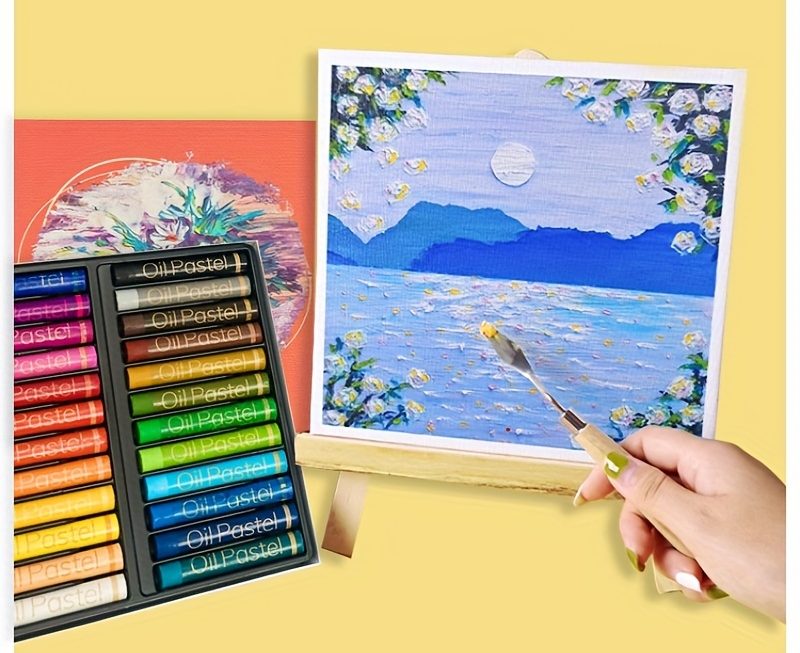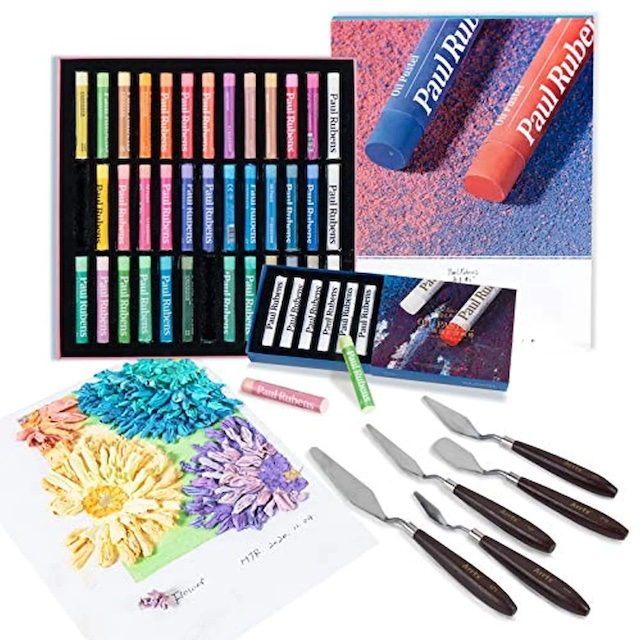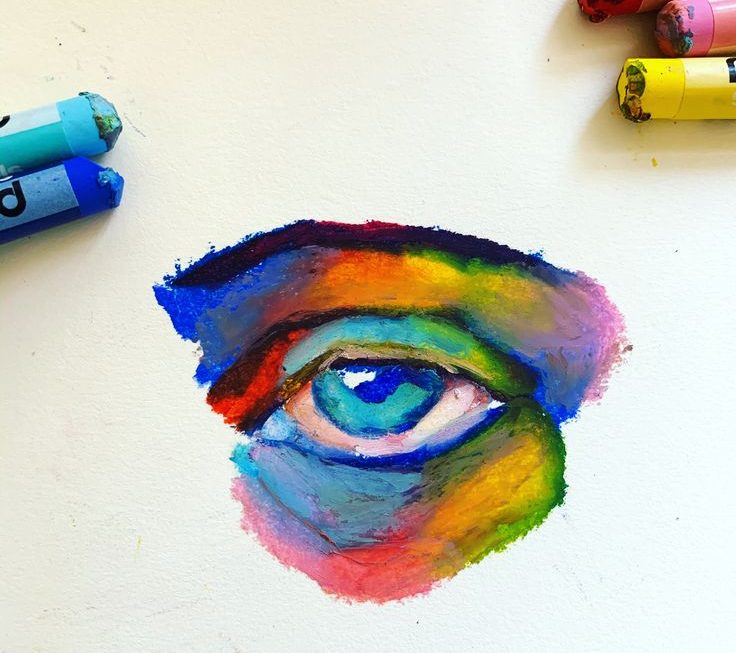Introduction
Oil pastel painting offers a wide range of creative possibilities. With their vibrant colors and creamy texture, oil pastels can be used to create beautiful and expressive works of art. Whether you’re a beginner or an experienced artist, there are countless oil pastel painting ideas to explore. Oil pastels are a versatile and vibrant medium that can be used to create stunning works of art. Whether you’re new to oil pastel painting or have been using them for years, there are countless creative possibilities to explore. In this article, we’ll explore 10 inspiring oil pastel painting ideas that are perfect for beginners. From simple still life compositions to colorful abstracts, there’s something for everyone to try.
Part 1: Getting Started with Oil Pastels
Level 1: Understanding the Basics
Before diving into specific painting ideas, it’s important to have a basic understanding of oil pastels. These vibrant, wax-based crayons can be used on a variety of surfaces, from paper to canvas, and can be easily blended with your fingers or a blending tool.
Level 2: Exploring Techniques
Experiment with different techniques such as layering, blending, and impasto to create unique effects in your oil pastel paintings. For example, layering different colors and blending them together can create rich, textured surfaces, while applying thick layers of oil pastel (impasto) can add dimension and depth to your artwork.
Part 2: Expressive Landscapes
One popular subject for oil pastel paintings is landscapes. The rich, blendable colors of oil pastels make them perfect for capturing the natural beauty of the outdoors. You can experiment with different techniques to depict the changing colors of the seasons, the texture of mountains and forests, and the reflections in water. Whether you’re painting a serene rural scene or a dramatic sunset, oil pastels can help you capture the mood and atmosphere of the landscape.
Level 1: Capturing Nature’s Beauty
Oil pastels are the perfect medium for capturing the beauty of landscapes. Experiment with different color palettes and mark-making techniques to create expressive and vibrant landscapes, from serene seascapes to majestic mountainscapes.
Level 2: Adding Depth and Perspective
Use the layering and blending techniques you’ve learned to add depth and perspective to your landscape paintings. Experiment with foreground, middle ground, and background elements to create a sense of depth and distance in your artwork.
Part 3: Colorful Abstracts
Still life paintings are another great option for oil pastel artists. You can arrange and light a still life setup and use oil pastels to create a vibrant and textured representation of objects such as fruit, flowers, or everyday items. With oil pastels, you can experiment with layering and blending to achieve a realistic or more abstract look.
Portraits and figures are another popular subject for oil pastel paintings. The rich, pigmented colors of oil pastels can be used to create expressive and vibrant portraits. You can experiment with different techniques to capture the personality and emotions of the subject, and use the creamy texture of oil pastels to create interesting and dynamic compositions.
Level 1: Embracing Your Creativity
Abstract art is the perfect opportunity to let your creativity run wild. Use bold and vibrant colors, varied textures, and dynamic compositions to create expressive and unique abstract oil pastel paintings.
Level 2: Experimenting with Mark-making
Explore different mark-making techniques to add movement and energy to your abstract paintings. From bold, sweeping gestures to intricate patterns, mark-making can add visual interest and depth to your artwork.
Part 4: Still Life Compositions
Level 1: Finding Beauty in Everyday Objects
Still life compositions are a classic subject for artists and a great way to practice observation and technique. Try setting up a simple still life arrangement using objects from around your home and experiment with different lighting and angles.
Level 2: Capturing Texture and Form
Use the layering and blending techniques you’ve learned to capture the textures and forms of the objects in your still life compositions. Pay attention to the interplay of light and shadow to create a sense of volume and dimension in your paintings.
Part 5: Animal Portraits
Level 1: Bringing Animals to Life
Oil pastels are a great medium for capturing the beauty and personality of animals. Whether you’re drawing a beloved pet or a wild creature, experiment with different colors and techniques to bring your animal portraits to life.
Level 2: Focusing on Expressive Details
Pay attention to the expressive details of your animal portraits, such as the textures of fur or feathers, the sparkle in their eyes, and the subtle variations in color. Use your oil pastels to capture these details and bring a sense of life and personality to your artwork.
Part 6: Sunset Seascapes
Oil pastels are an excellent medium for capturing the vibrant colors of a sunset over the ocean. Start by choosing a piece of heavy paper or canvas for your painting. Begin by sketching a basic outline of the horizon and the basic shapes of the waves using a light blue or purple oil pastel. Then, gradually blend warmer tones like oranges, pinks, and yellows to create the stunning colors of a sunset. Use a blending tool or even your fingers to blend the colors seamlessly. Remember to add highlights and reflections on the water to add depth and realism to your seascapes. Experiment with different techniques and colors to create a unique and captivating sunset seascape with oil pastels.
Part 7: Floral Still Life
Another oil pastel painting idea is to create a vibrant floral still life. Start by selecting a variety of flowers with different shapes and colors to create an interesting composition. Use a dark background like black or deep blue to make the colors of the flowers pop. Begin by sketching the outline of the flowers and leaves, then gradually layer and blend different shades of oil pastels to create depth and dimension. Pay attention to the different textures and patterns of the petals and leaves to make your still life more realistic. Add highlights and shadows to create a three-dimensional effect. Remember to experiment with different color combinations and techniques to create a beautiful, lifelike floral still life with oil pastels.
Part 8: Cityscape
Oil pastels are also a great medium for capturing the dynamic energy of a cityscape. Start by choosing a reference photo of a city skyline that inspires you. Begin by sketching the basic outline of the buildings and landmarks using black or dark blue oil pastel. Then, gradually layer and blend different colors to create the vibrant lights and reflections of a city at night. Experiment with different techniques to create interesting textures for the various architectural elements. Pay attention to the different light sources to add depth and atmosphere to your cityscape. Add details like cars, people, and streetlights to enhance the atmosphere of your painting. With oil pastels, you can create a bold and vibrant cityscape full of energy and life.
Conclusion
Oil pastel painting offers endless creative possibilities for artists of all levels. Whether you’re a beginner or an experienced artist, there are countless subjects and techniques to explore with oil pastels. From landscapes and abstracts to still life compositions and animal portraits, the vibrant colors and versatile nature of oil pastels make them a truly fun and rewarding medium to work with. So, grab your oil pastels and start exploring these inspiring painting ideas today!






